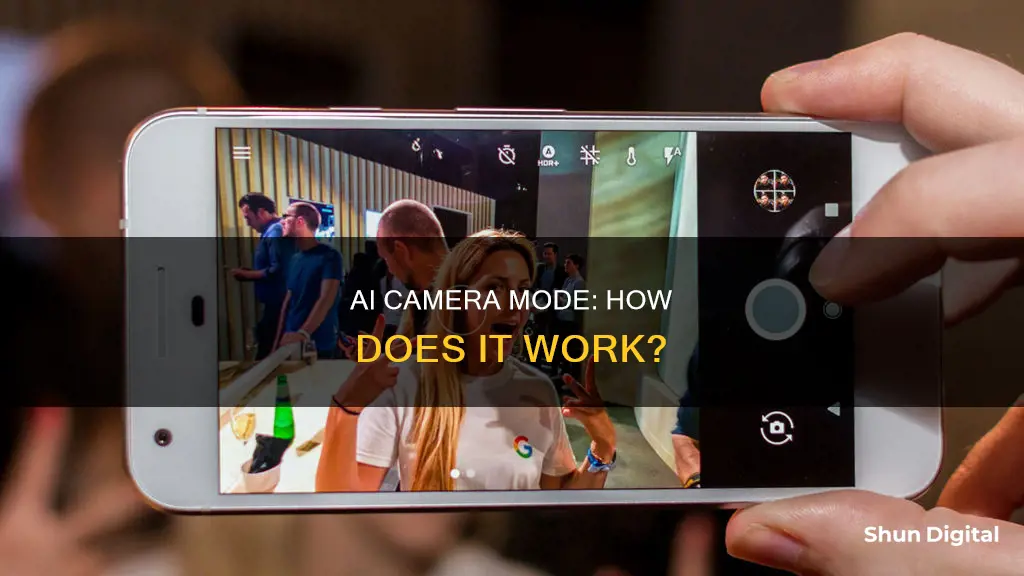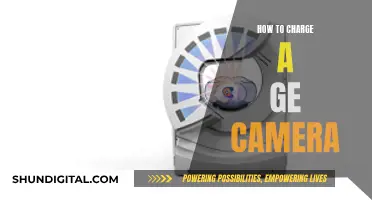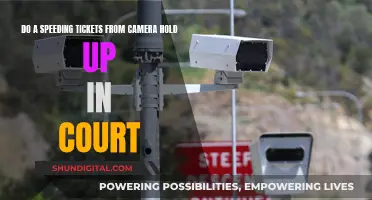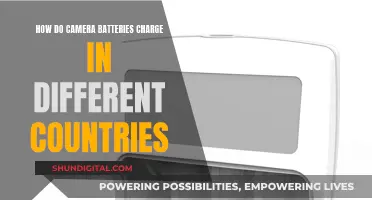
AI stands for Artificial Intelligence, which is a branch of computer science that enables machines to think, learn and problem-solve. AI cameras in smartphones use Artificial Intelligence mode to capture images, enhancing the quality of the photos taken. AI cameras can automatically recognise scenes, adjust lighting conditions, and make dynamic exposure and colour adjustments. They can also add effects, such as the bokeh effect, which blurs the background of an image. AI cameras can be trained to understand camera settings and image processing, and can help amateur photographers choose the most applicable exposure and colour adjustments for the perfect shot.
| Characteristics | Values |
|---|---|
| Purpose | Elevates your photography game |
| Functionality | Analyses image data automatically, compares image to a huge database of related images, offers thousands of angles to frame the shot better |
| Use Cases | Scene recognition, automatic shutter speed and exposure, image/face recognition, voice-to-text composition, intelligent tone mapping, long exposure, night mode, portrait mode, aperture mode |
| Benefits | No need to master any new or complex tools, enables mobile devices to create flawless and stunning images, improves image quality, enhances the quality of smartphone cameras, removes flaws in the images |
What You'll Learn
- AI mode can automatically recognise scenes, light conditions, and angles
- AI cameras can identify objects and scenes and suggest effects
- AI can enhance images by reducing motion blur and adding simulated depth of field
- AI can identify and remove unwanted objects from images
- AI can adjust lighting and colour balance to improve representation of people of colour

AI mode can automatically recognise scenes, light conditions, and angles
AI mode in mobile cameras can be a powerful tool for photographers of all skill levels. One of its key features is the ability to automatically recognise scenes, light conditions, and angles, enhancing the convenience and creativity of mobile photography.
Scene recognition is a standout capability of AI mode, allowing it to identify common themes and contexts within images. By processing billions of photos annually, AI algorithms can distinguish between various subjects, such as newborns, landscapes, sunsets, and cityscapes. This enables the camera to apply tailored corrections and enhancements, ensuring optimal image quality for each unique scene.
Light conditions play a crucial role in photography, and AI mode excels at assessing lighting scenarios. It can differentiate between well-lit environments and low-light conditions, adjusting exposure and enhancing details accordingly. Whether it's a backlit image, a night scene in a bar, or a sunset landscape, AI mode optimises lighting to bring out the best in every shot.
Additionally, AI mode is adept at recognising angles and camera positions, which are essential for evoking emotions and supporting the narrative of an image. From eye-level shots that foster a sense of connection with the subject to high-angle shots that convey strength or defenselessness, AI mode can suggest or automatically apply these angles to enhance visual impact.
The ability to recognise and adapt to different scenes, light conditions, and angles empowers photographers to capture moments with precision and creativity. AI mode simplifies the technical aspects of photography, allowing users to focus on their artistic vision and storytelling. With its advanced scene recognition, lighting adjustments, and angle suggestions, AI mode elevates the mobile photography experience, making it more accessible and dynamic.
Understanding AE Mode: Camera's Auto Exposure Explained
You may want to see also

AI cameras can identify objects and scenes and suggest effects
AI cameras are capable of identifying objects and scenes and suggesting effects, enhancing the photography experience for both professionals and amateurs. This technology utilises machine learning algorithms and deep learning algorithms, which are a more advanced form of machine learning that employs neural networks for image analysis.
AI cameras can automatically adjust camera settings and identify objects, faces, and scenes. This enables features such as facial recognition, object detection, and scene recognition, which are not possible with traditional cameras. For instance, AI can identify a person's face and apply a "bokeh" blur effect, simulating a portrait taken in a studio. It can also differentiate between the foreground subject and the background, allowing for a stepless zoom effect.
The benefits of AI cameras extend beyond creative effects. They can improve image quality by optimising camera settings, even in challenging conditions. This technology is particularly useful in low-light environments, where it enables the impressive "night mode" on smartphone cameras. Additionally, AI cameras are easier to use, making it more accessible for beginners to capture high-quality photos and videos.
While AI cameras offer enhanced capabilities, they are not without limitations. They can misidentify objects or struggle with correct focusing at times. The cost of AI cameras is typically higher than that of traditional cameras, and they require extensive data for training, which can be time-consuming and expensive to obtain.
Despite these limitations, AI cameras show promising potential for the future of photography. As AI technology advances, costs are expected to decrease, making this innovative technology more accessible. With ongoing improvements, AI cameras will become even more accurate in object and scene identification, and their ability to adjust camera settings will continue to enhance photographic results.
Understanding Raw Image Files in Photography
You may want to see also

AI can enhance images by reducing motion blur and adding simulated depth of field
AI-powered tools can enhance images by reducing motion blur and adding simulated depth of field. This technology is useful when you want to fix a blurry image or add creative effects to your photos.
Reducing Motion Blur
Motion blur occurs when either the camera or the subject moves during the exposure, resulting in a blurry image. This can be caused by "camera shake" or subject movement, especially in low-light settings where a longer shutter speed is required. AI tools can effectively reduce motion blur by detecting the blur and determining what the image should look like when crisp and clear. This process can bring back sharpness and clarity to images, making it appear as if there was never any blur to begin with.
Adding Simulated Depth of Field
The depth of field in an image refers to the area that appears to be in focus. AI can simulate depth of field in images by using various techniques. One method is aperture simulation, where the simulated aperture is adjusted to control the depth of field, resulting in either a shallower or deeper depth of field. Another technique is masking and blurring, where masks are manually created to isolate different areas of the image, and blurring effects are applied to specific regions to create a shallow depth of field. Depth maps are also used to encode depth information and simulate depth of field effects in post-processing. Additionally, third-party filters and plugins are available to simulate depth of field without the need for complex manual adjustments.
AI Mode in Mobile Cameras
Many newer smartphones have built-in AI capabilities in their cameras, allowing for features like depth of field simulation and motion blur reduction. Additionally, there are mobile applications that utilize AI to enhance images. These tools provide users with creative control and the ability to fix common issues like blurry images.
Unleashing Camera Raw: Mastering the Art of Masking
You may want to see also

AI can identify and remove unwanted objects from images
AI-powered smartphone cameras are becoming increasingly common, and they can be used to identify and remove unwanted objects from images. AI can automatically identify and remove unwanted objects from images, such as watermarks, timestamps, logos, and other distractions, to create a cleaner and more visually pleasing image. This can be done in just a few simple steps by selecting the object with a brush tool or similar, and then clicking "remove".
AI-powered photo editing tools, such as Photoroom, PicWish, and SnapEdit, can be used to enhance images by removing unwanted objects, people, or text. These tools use machine learning and neural networks to understand images and make adjustments. They can also be used to improve image quality, lighting, and composition, as well as add effects such as bokeh blur.
AI-powered cameras and photo editing tools have made it easier for people to take high-quality, professional-looking photos without needing extensive photography knowledge or expensive equipment. These tools can automatically adjust settings such as shutter speed, exposure, saturation, colour depth, dynamic range, and contrast. They can also recognise scenes, lighting conditions, and angles to apply the most suitable adjustments.
AI has blurred the boundaries between image capture, enhancement, and manipulation, and it continues to advance and impact the field of photography.
Low Power Mode: Impact on Camera Quality
You may want to see also

AI can adjust lighting and colour balance to improve representation of people of colour
AI camera modes on mobile phones use advanced algorithms to automatically enhance lighting and colour balance, improving the representation of people of all skin tones. AI technology can identify areas of a photo that need adjustment and make changes to the lighting and colour balance to ensure the best representation of the subject. This is particularly useful for people of colour, as traditional photography and editing techniques have often failed to accurately represent darker skin tones.
AI camera modes can adjust lighting by refining edges, removing artefacts, and optimising light and contrast levels. This ensures that photos are vibrant and well-lit, with the correct exposure, shadows, and highlights. AI can also adjust the white and black levels, exposure, contrast, and saturation to improve lighting. These adjustments can be made in seconds, saving time and achieving stunning visual results.
AI can also improve colour balance and vibrancy, ensuring that colours are true and consistent across all scenes. This is especially useful for improving the representation of people of colour, as skin tones can be accurately captured and represented. AI colour correction tools can remove colour casts from images, bringing out colours for more clarity and vitality.
AI camera modes can also be used to fix common issues with mobile photography, such as overexposure or underexposure, and can even be used to enhance old, distorted, or torn images. Overall, AI camera modes can significantly improve the representation of people of colour in mobile photography by optimising lighting and colour balance and producing vibrant, well-lit images with accurate colour representation.
Where to Buy Camera Batteries: Walgreens and Beyond
You may want to see also
Frequently asked questions
AI mode in mobile cameras uses artificial intelligence to enhance the quality of photos. It can automatically recognise scenes, adjust lighting and colour, and add effects to create the best image possible.
AI mode combines the capabilities of a professional camera with editing features that were previously only available via expensive editing software. It can also use HDR+ technology to take multiple pictures in quick succession and combine them into a single, blur-free image.
AI mode can elevate your photography by allowing you to take sharp photos in low light, removing unwanted items, unblurring faces, and getting the best group photos. It can also add special effects and enable you to shoot in low light.
Examples of AI camera features include AI Mode, which detects the subject in the frame and adjusts settings accordingly; Portrait Mode, which enhances facial features; Aperture Mode, which controls the amount of light let in; and Night Mode, which increases sharpness in low-light conditions.
AI mode can be used in conjunction with composition guidelines such as the Rule of Thirds and the Composition Spiral Guideline to improve the framing and composition of your photos.







